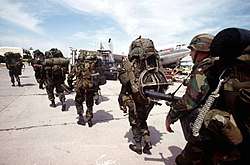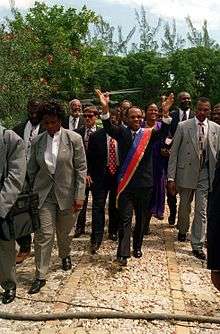Operation Uphold Democracy
| Operation Uphold Democracy | |||||||
|---|---|---|---|---|---|---|---|
 Soldiers of C Company, 2nd Battalion 22nd Infantry, 10th Mountain Division securing Port-au-Prince Airport on the first day of Operation Uphold Democracy | |||||||
| |||||||
| Belligerents | |||||||
|
|
| ||||||
| Commanders and leaders | |||||||
|
|
| ||||||
| Strength | |||||||
|
|
| ||||||
| Casualties and losses | |||||||
|
|
| ||||||
Operation Uphold Democracy (19 September 1994 – 31 March 1995) was a military intervention designed to remove the military regime installed by the 1991 Haitian coup d'état that overthrew the elected President Jean-Bertrand Aristide. The operation was effectively authorized by the 31 July 1994 United Nations Security Council Resolution 940.
History
The operation began with the alert of United States and its allies for a forced entry into the island nation of Haiti. U.S. Navy, U.S. Coast Guard, and U.S. Air Force elements staged to Puerto Rico and southern Florida to prepare to support the airborne invasion, spearheaded by elements of the Joint Special Operations Command[1] (HQ, 75th Ranger Regiment), followed by 3rd Special Forces Group, the US Army 7th Transportation Group (Army watercraft and terminal elements) and the 10th Mountain Division. Some of these elements were staged out of Hunter Army Airfield and Guantanamo Bay Naval Base. The 1st Brigade of the 10th Mountain Division deployed to Haiti aboard the U.S.S Eisenhower.[2][3] The operation was directed by Commander, Joint Task Force 120 (JTF-120), provided by Commander, Carrier Group Two.[4]
As these forces prepared to invade, with the lead elements of the 82nd Airborne Division already in the air, a diplomatic element led by former President Jimmy Carter, U.S. Senator Sam Nunn and retired Chairman of the Joint Chiefs of Staff General Colin Powell persuaded the leaders of Haiti to step down and allow the elected officials to return to power. The main leader holding power was General Joseph Raoul Cédras and was the key focus of the delegation. General Powell's personal relationship with Cédras, from when Cédras was a student in the School of the Americas as a young officer, played a significant role in the American delegation gaining an audience with the dictator and enabling the conduct of negotiations for approximately two weeks.
Despite the insistent diplomatic efforts of the American delegation and the insinuation that force would be used if required, negotiations were at a virtual stalemate for the entire time with General Cédras obstinately refusing to concede to the legitimacy of the democratic elections. As a final effort to force the dictator to step down without violence, the delegation presented General Cédras with a video feed of the 82nd Airborne Division's aircraft being loaded with troops, with the Division's DRF-1 (Division Ready Force 1, the Battalion designated first to deploy, with its equipment and vehicles pre-loaded for parachute drop world-wide) 1st Battalion, 325th Airborne Infantry Regiment "Red Falcons" already deployed to Ft. Sherman, Panama. Therefore, the 2nd Battalion, 325th AIR "White Falcons" were attached to the 1st Brigade, 82nd Airborne Division Ready Brigade-1 (DRB-1).[5] While allowing Cédras to process the panic-inducing sight, he was informed that while he assumed he was watching a live feed, he was in fact viewing a video captured more than 2 hours before. As such, the lead elements of the 3,900-strong paratrooper force[6] had already launched from Fort Bragg, NC and were currently over the Atlantic Ocean. They further informed him of the United States' commitment to supporting democracy and that a forced-entry airborne assault on the island nation would, in all likelihood, result in Haiti coming under U.S. control before the next sunrise.
The delegation proceeded to issue a final ultimatum to the dictator. His choices were to either recognize the wish of the Haitian people as expressed through the democratic election of Father Jean-Bertrand Aristide and quietly retire, or continue to deny the election's outcome; in which case the U.S. would forcibly wrest control of his country and see justice done. To remove all uncertainty from the general's mind, he was reminded by the delegation that the 82nd Airborne Division had also spearheaded overwhelmingly decisive victories during Operation Urgent Fury in Grenada and Operation Just Cause in Panama in the recent past. Within minutes, General Cédras capitulated under the most favorable terms available to him at that time.
With his capitulation, the 100-plus aircraft carrying the 82nd Airborne Division were either turned around in mid-air or unloaded before they had a chance to take off. The paratroopers returned to their unit areas on Fort Bragg and they resumed their ready status; only to have the DRF-1 unit, Task Force Panther, deployed to Panama for Operations Safe Haven and Safe Passage on 12 December 1994. The military mission changed from a combat operation to a peacekeeping and nation-building operation with the deployment of the US-led multinational force in Haiti. This force was made up primarily of members of the 3rd Special Forces Group, but also included members of the 16th Military Police Brigade (Fort Bragg, NC), the 101st Military Police Company and 101st Aviation Brigade (Ft. Campbell, KY), 1/2 ACR from Ft. Polk LA and Marine Forces Caribbean. Teams were deployed throughout the country to establish order and humanitarian services. Regular Army forces consisting of units from the 10th Mountain Division occupied Port-au-Prince with 3rd Bn (Airborne) 73rd Armor Regiment (82nd Airborne Division) and elements from the U.S. Army Materiel Command provided logistical support in the form of the Joint Logistics Support Command (JLSC) which provided oversight and direct control over all Multinational Force and U.S. deployed logistics units. This included the 46th Support Group, the Joint Material Management Center, JMMC and the follow on civilian contractor LOGCAP. Additionally, the 28th CASH (Combat Support Hospital) provided medical care for service members and Haitians alike. A Joint Psychological Operations Task Force (JPOTF) comprised primarily of elements from The United States Army's 4th Psyop Group (Airborne) and reserve augmentees provided continuous, effective information operations support throughout Uphold Democracy and successive operations.[7]
The United States Coast Guard played a significant role in the operation, providing command, control and communications services from the USCGC Chase, a 378' high endurance cutter anchored in Port-au-Prince Harbor. Numerous 210' and 270' medium endurance cutters, a 180' buoy tender USCGC Papaw, as well as 110' patrol boats worked with Navy SEAL gunboats to provide security for forces entering and exiting the twelve-mile exclusion zone and Port-au-Prince Harbor. In August 1994, the Battalion departed for the Caribbean and Haitian waters for Operation Support Democracy. 2nd Battalion, 2nd Marines once again landed in Cap Haitian, Haiti on 20 September 1994. Participation in Operation Uphold Democracy lasted until October 1994. A squad from Echo Company engaged in a firefight with coup-supporting elements of the Haitian police and military. Fourteen Marines, led by Lt. Polumbo, prevailed despite superior numbers and superior cover by the Haitians. One Navy interpreter was wounded and several Haitians lost their lives. The 10th Mountain Division was relieved in place by units of the 25th Infantry Division (Light) under command of Major General George A. Fisher Jr. The 25th Infantry Division deployed on 4 January 1995 from their home station of Schofield Barracks, Hawaii and officially assumed command authority from the 10th Division on 9 January 1995. General Fisher and the 25th Infantry Division were the headquarters element of what is officially known as the Multinational Forces, Combined Task Force 190, Republic of Haiti.
The U.S. Army Reserve unit, 458th Transportation Detachment (ATMCT), Belleville, Illinois, was activated and reported to Fort Bragg, North Carolina within 48 hours of notification. This was the fastest a Reserve unit has ever been deployed. The 458th manned the 18th Corps Joint Movement Control Center (JMCC) in support of the mission.

Father Jean Bertrand Aristide returned to Haiti in October 1994 after 3 years of forced exile.[8] Operation Uphold Democracy officially ended on 31 March 1995, when it was replaced by the United Nations Mission in Haiti (UNMIH). US President Bill Clinton and Haitian President Jean Bertrand Aristide presided over the change of authority ceremony. From March 1995 until March 1996, 2,400 U.S. personnel from the original Operation Uphold Democracy remained as a UNMIH-commanded support group under the aegis of Operation New Horizons.[9] A large contingent of U.S. troops (USFORHAITI) participated as peacekeepers in the UNMIH until 1996 (and the U.S. forces commander was also the commander of the U.N. forces). U.N. forces under various mission names were in Haiti from 1995 through 2000. Over the course of the operation one U.S. soldier, a Special Forces staff sergeant, was killed. The soldier died after being struck by gunfire at a roadside checkpoint.[10][11]
Three Argentine Navy corvettes of the Drummond class joined the mission to force the commercial embargo of Haiti.[12]
References
- ↑ Joint Special Operations Command
- ↑ "U.S.S. Eisenhower departs for Haiti with 10th Mountain soldiers". National Archives. September 14, 1994.

- ↑ "History of 1st Brigade Combat Team, 10th Mountain Division". U.S. Army, Fort Drum. 2010.

- ↑ "Carrier Group Two". Military. GlobalSecurity.org. April 26, 2005. Retrieved November 13, 2010.
- ↑ Pike, John. "2nd Battalion, 325th Airborne Infantry Regiment". www.globalsecurity.org.
- ↑ https://wwwglobalsecurity.org/military/ops/uphold_democracy.htm
- ↑ "The 1st Psychological Operations Battallion (Airborne)". www.psywarrior.com. Retrieved 2018-06-13.
- ↑ Von Hippel, Karin (2000). Democracy by Force. United Kingdom: Cambridge University Press. p. 96.
- ↑ John Pike. "Operation New Horizons, globalsecurity.org 05.07.2011". Retrieved 1 November 2014.
- ↑ "U.S. Soldier Dies, Another Hurt in Gunfight in Haiti". latimes. 1995-01-13. Retrieved 2018-01-12.
- ↑ P. Girard (9 December 2004). Clinton in Haiti: The 1994 US Invasion of Haiti. Palgrave Macmillan US. pp. 127–. ISBN 978-1-4039-7931-5.
- ↑ "con el propósito de asegurar el cumplimiento del embargo comercial, dispuesto por el Consejo de Seguridad, por medio de las corbetas ARA Grandville, ARA Guerrico y ARA Drummond.". Retrieved 1 November 2014.
Further reading
- "President Carter Leads Delegation to Negotiate Peace With Haiti". http://www.cartercenter.org, The Carter Center. Retrieved 24 September 2009.
- "Operation Uphold (Restore) Democracy – Haiti". www.au.af.mil, Maxwell-Gunter Airforce base. Retrieved 30 July 2006.
- "Deployments – Haiti – Operation Uphold Democracy – Background". www.pdhealth.mil, Deployment Health Clinical Center. Archived from the original on 29 May 2007. Retrieved 6 October 2006.
- "Operation New Horizons". www.globalsecurity.org. Retrieved 10 July 2007.
- Award Certificate of Sergeant First Class Gary D. Soots, 25th Infantry Division